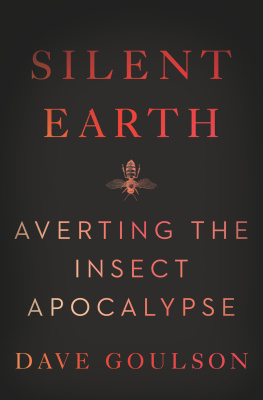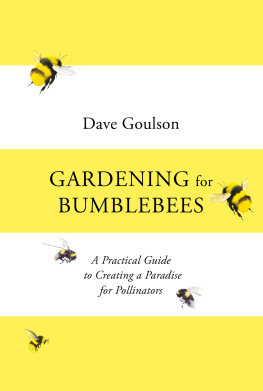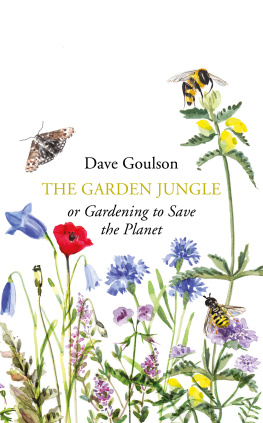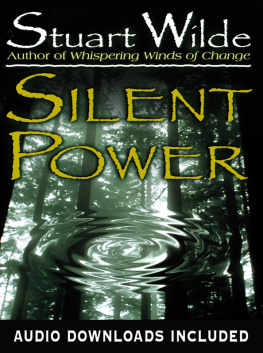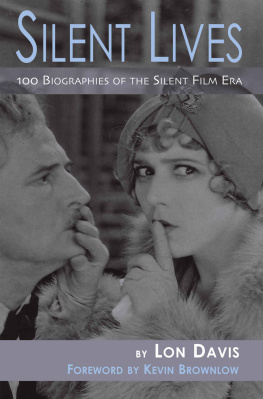Dave Goulson - Silent Earth: Averting the Insect Apocalypse
Here you can read online Dave Goulson - Silent Earth: Averting the Insect Apocalypse full text of the book (entire story) in english for free. Download pdf and epub, get meaning, cover and reviews about this ebook. year: 2021, publisher: Harper, genre: Romance novel. Description of the work, (preface) as well as reviews are available. Best literature library LitArk.com created for fans of good reading and offers a wide selection of genres:
Romance novel
Science fiction
Adventure
Detective
Science
History
Home and family
Prose
Art
Politics
Computer
Non-fiction
Religion
Business
Children
Humor
Choose a favorite category and find really read worthwhile books. Enjoy immersion in the world of imagination, feel the emotions of the characters or learn something new for yourself, make an fascinating discovery.
- Book:Silent Earth: Averting the Insect Apocalypse
- Author:
- Publisher:Harper
- Genre:
- Year:2021
- Rating:5 / 5
- Favourites:Add to favourites
- Your mark:
- 100
- 1
- 2
- 3
- 4
- 5
Silent Earth: Averting the Insect Apocalypse: summary, description and annotation
We offer to read an annotation, description, summary or preface (depends on what the author of the book "Silent Earth: Averting the Insect Apocalypse" wrote himself). If you haven't found the necessary information about the book — write in the comments, we will try to find it.
Dave Goulson: author's other books
Who wrote Silent Earth: Averting the Insect Apocalypse? Find out the surname, the name of the author of the book and a list of all author's works by series.
Silent Earth: Averting the Insect Apocalypse — read online for free the complete book (whole text) full work
Below is the text of the book, divided by pages. System saving the place of the last page read, allows you to conveniently read the book "Silent Earth: Averting the Insect Apocalypse" online for free, without having to search again every time where you left off. Put a bookmark, and you can go to the page where you finished reading at any time.
Font size:
Interval:
Bookmark:
A Sting in the Tale
A Buzz in the Meadow
Bee Quest
The Garden Jungle
Gardening for Bumblebees
SILENT EARTH . Copyright 2021 by Dave Goulson. All rights reserved under International and Pan-American Copyright Conventions. By payment of the required fees, you have been granted the nonexclusive, nontransferable right to access and read the text of this e-book on-screen. No part of this text may be reproduced, transmitted, downloaded, decompiled, reverse-engineered, or stored in or introduced into any information storage and retrieval system, in any form or by any means, whether electronic or mechanical, now known or hereafter invented, without the express written permission of HarperCollins e-books.
Originally published in the United Kingdom in 2021 by Jonathan Cape, an imprint of Vintage.
FIRST U . S . EDITION
Cover design by Caroline Johnson
Cover illustration channarongsds/iStock/Getty Images
Digital Edition SEPTEMBER 2021 ISBN: 978-0-06-308822-1
Version 08042021
Print ISBN: 978-0-06-308820-7
For my crazy, frustrating, beautiful family and, most of all, for my lovely wife Lara.
I have been fascinated by insects all my life. One of my earliest memories is of finding, at the age of five or six, some stripy yellow and black caterpillars feeding on weeds growing from the cracks in the tarmac at the edge of the school playground. I gathered them up, placing them among the crumbs in my empty lunchbox, and took them home. With the help of my parents I found more of the right type of leaves for them to feed on, and eventually the caterpillars transformed into handsome magenta and black moths (European readers might recognise them as cinnabar moths). This seemed like magic to me and still does. I was hooked.
Since then, Ive somehow managed to make a living from my childhood hobby. As a teenager I spent every weekend and holiday chasing after butterflies with a net, sugaring for moths, and using pitfall traps to catch beetles. I bought the eggs of exotic moths from specialist mail-order suppliers and watched them grow into bizarre, rainbow-coloured caterpillars and eventually become huge, glorious moths: green moon moths with long tail streamers from India, peacock moths with flashing false eyes from Madagascar, and giant chocolate-brown Atlas moths, the biggest moth species of all, from South-East Asia. Inevitably I chose to study biology when I got a place at Oxford University, and later I did my PhD on butterfly ecology at Oxford Brookes, the rather less posh university perched on a hill to the east of Oxford. Following that, I managed to get various research posts: first, one back at Oxford University looking at the extraordinary mating habits of death-watch beetles, and then one at a government lab in Oxford studying ways to control moth pests by spraying crops with viruses. Since I didnt like killing insects I loathed this last job, and was enormously relieved when I was offered a permanent faculty position in the Biology Department at Southampton University.
It was there that I began specialising in bumblebees, for me the most endearing of insects (and they have stiff competition). I became fascinated by how bumblebees choose which flowers to visit, and spent five years unravelling how they avoid empty flowers by sniffing them for the faint whiff of a recent bumblebee visitors smelly feet. I came to learn that, behind their bumbling, teddy-bear appearance, bumblebees are smart, the intellectual giants of the insect world, able to navigate and memorise the locations of landmarks and flower patches, efficiently extract rewards hidden in elaborate flowers, and live in complex social colonies where plots are hatched and regicide is common. Compared to them, the butterflies I had chased as a youth now seemed beautiful but airheaded creatures.
In pursuit of insects I have been lucky enough to travel the world, from the deserts of Patagonia to the icy peaks of Fjordland in New Zealand and the humid, forested mountains of Bhutan. I have watched clouds of birdwing butterflies sipping minerals from the muddy banks of a river in Borneo, and thousands of fireflies flashing their luminous bottoms in synchrony at night in the swamps of Thailand. At home in my garden in Sussex I have spent countless hours on my stomach, watching grasshoppers court a mate and see off rivals, earwigs tend their young, ants milk honeydew from aphids, and leafcutter bees snip leaves to line their nests.
I have had enormous fun. But I have been haunted by the knowledge that these creatures are in decline. It is fifty years since I first collected those caterpillars in the school playground, and every year that has passed since there have been slightly fewer butterflies, fewer bumblebees fewer of almost all the myriad little beasts that make the world go round. These fascinating and beautiful creatures are disappearing, ant by ant, bee by bee, day by day. Estimates vary and are imprecise, but it seems likely that insects have declined in abundance by 75 per cent or more since I was five years old. The scientific evidence for this grows stronger every year, as more and more studies are published describing the collapse of monarch butterfly populations in North America, the demise of woodland and grassland insects in Germany, or the seemingly inexorable contraction of the ranges of bumblebees and hoverflies in the UK.
In 1963, two years before I was born, Rachel Carson warned us in her book Silent Spring that we were doing terrible damage to our planet. She would weep to see how much worse it has become. Insect-rich wildlife habitats such as hay meadows, marshes, heathland and tropical rainforests have been bulldozed, burnt or ploughed to destruction on a vast scale. The problems with pesticides and fertilisers she highlighted have become far more acute, with an estimated three million tons of pesticides now going into the global environment every year. Some of these new pesticides are thousands of times more toxic to insects than any that existed in Carsons day. Soils have been degraded, rivers choked with silt and polluted with chemicals. Climate change, a phenomenon unrecognised in her time, now threatens to further ravage our beleaguered planet. These changes have all happened in our lifetime, on our watch, and they continue to accelerate.
The decline of insects is terribly sad for those of us who love these little creatures and value them for themselves, but it also threatens human well-being, for we need insects to pollinate our crops, recycle dung, leaves and corpses, keep the soil healthy, control pests, and much, much more. Many larger animals such as birds, fish and frogs rely on insects for food. Wildflowers rely on them for pollination. As insects become more scarce, our world will slowly grind to a halt, for it cannot function without them. As Rachel Carson said, Man is a part of nature, and his war against nature is inevitably a war against himself.
I now spend much of my time trying to persuade other people to love and care for insects, or at the very least to respect them for all the vital things they do. That, of course, is why I wrote this book. I want you to see insects as I do: as beautiful, surprising, sometimes surpassingly strange, sometimes sinister and disturbing, but always marvellous, and deserving of our esteem. You will, I think, be amazed at some of their more peculiar habits, life cycles and behaviours, which make the imaginings of science fiction writers seem ploddingly mundane. As we explore the world of insects, their evolutionary history, their importance, and the many threats that they face, the chapters are separated by short interludes brief explorations of the lives of some of my favourite insects.
Font size:
Interval:
Bookmark:
Similar books «Silent Earth: Averting the Insect Apocalypse»
Look at similar books to Silent Earth: Averting the Insect Apocalypse. We have selected literature similar in name and meaning in the hope of providing readers with more options to find new, interesting, not yet read works.
Discussion, reviews of the book Silent Earth: Averting the Insect Apocalypse and just readers' own opinions. Leave your comments, write what you think about the work, its meaning or the main characters. Specify what exactly you liked and what you didn't like, and why you think so.

